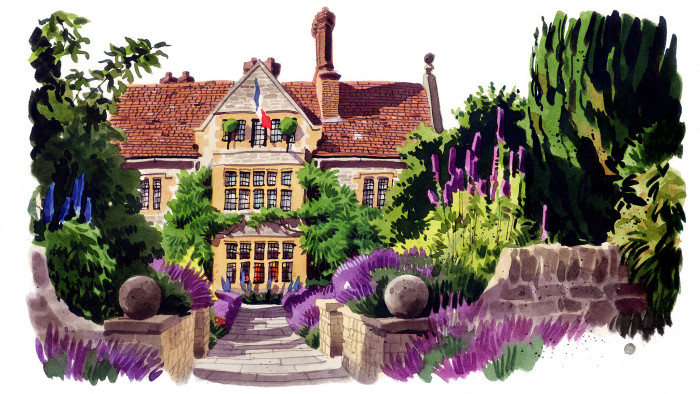Postcard from . . . Le Manoir aux Quat’Saisons, Oxfordshire

Roula Khalaf, Editor of the FT, selects her favourite stories in this weekly newsletter.
“We don’t mind ugly vegetables, so long as they taste good,” says Anne Marie Owens, head gardener at Le Manoir aux Quat’Saisons, Raymond Blanc’s French-infused English country hotel in Oxfordshire.
It’s just as well. In the hotel’s two-acre vegetable garden, which provides ingredients to the brigade of 50 chefs in the hotel’s two-Michelin-star restaurant, there are 2ft-long snake gourds, curly cucumbers, whopping beetroots and turnips, all of which taste incredible but would probably fall foul of the supermarket one-size-fits-all standard.
I’m here for a one-day gardening course based in the hotel’s beautiful Hartley Botanic glasshouse. It is a new venture for Blanc and the hotel claims it is the first of its kind in the UK.
With so much focus on local, sustainable and organic ingredients, kitchen gardens are in vogue among Britain’s luxury hotels. Forest Side — a recently opened Lake District hotel with a one-Michelin-starred restaurant — is offering tours of its garden, for example; the Pig chain of hotels in southern England make great play of their kitchen gardens, which are open to guests to wander around and some of which even contain cottages in which guests can sleep.
Meanwhile, many hotels offer foraging experiences on their grounds; most offer cookery classes. The Manoir’s cookery school is a key part of the business, and offers multi-day courses combined with stays — but the new course offers guests the chance to trace the production of their Michelin-starred meals back even further — from restaurant to kitchen and now to the garden.
There are full- and half-day courses, with topics such as autumn vegetables, micro-herbs and edible flowers, mushrooms, fruit-tree pruning and so on, as well as children’s courses in the company of Raymond’s son Olivier and a character called “Henri Le Worm”.
Naturally, we begin with a tour of the beds. It’s here that the day’s produce is all picked by 10am to allow the chefs time to prep for lunch. There is row upon row of chard, beetroot and beans galore, plus more exotic veg such as yacón, the Peruvian ground apple. Dotted in among them are edible flowers such as blue borage, with its peppery cucumber hit, violas, vibrant red bergamot, creamy nasturtiums, and more vibrant yellow dill beside rich blue and purple cornflowers.
“Are these used for garnish,” I ask head vegetable gardener Jen Pryke.
“There’s no such thing as garnish at Le Manoir,” she replies. Everything here contributes to the flavour in subtle ways. The dill pollen can be used to dust fish with a hint of the herb; purple oxalis gives an acidic hit and, to make her point, Pryke hands the class tiny leaves from a mystery plant for us to diligently chew. “Oysters!” someone exclaims. Pryke reveals the label: it’s the oyster plant (Mertensia maritima). A leaf or two sits atop the restaurant’s beef tartare dish.
Despite the seeming abundance, the garden supplies less than 20 per cent of the vegetables required by the kitchen. “The garden needs to add value,” explains Pryke. “It could be planted entirely with potatoes and still not satisfy the restaurant.” Instead, it provides vegetables that benefit from being freshly picked or that are hard to get in decent quantities. One polytunnel is almost entirely given over to courgettes (Nero di Milano), which provide about 9,000 flowers per year. If they were bought in, they would cost in the region of £1.50 each.
Back in the glasshouse, Pryke and Owens field questions in what rapidly becomes an impromptu Gardeners’ Question Time that shows the scope and breadth of the guests on the course: what vegetables would best suit a London townhouse garden? How can I deter deer from my large Home Counties vegetable patch? What can I grow on my Hong Kong rooftop?
It was just this sort of curiosity that sparked the desire to found the school, says Owens, who has worked at the hotel for more than 30 years. “Guests would tour the garden, ask questions, and the conversation would always turn to their own gardens,” she says.
And of course if it encourages more visitors to book a room and stay for dinner to sample those courgette flowers or the beef tartare, then so much the better.
Details
Carl Wilkinson was a guest of the Raymond Blanc Gardening School at Le Manoir aux Quat’Saisons. Half day courses cost from £110, full day from £185; double rooms cost from £595. The hotel is in the village of Great Milton, eight miles southeast of Oxford
Illustration by Matthew Cook
Follow @FTLifeArts on Twitter to find out about our latest stories first.
Subscribe to FT Life on YouTube for the latest FT Weekend videos.
Sign up for our Weekend Email here
Comments